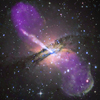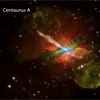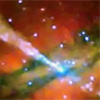CXC Home | Search | Help | Image Use Policy | Latest Images | Privacy | Accessibility | Glossary | Q&A
Tour of Centaurus A
Quicktime MPEG There is nothing subtle about the black hole in the galaxy Centaurus A. First off, it's about 10 million times more massive than the sun, and Chandra's X-ray image shows it's not just sitting quietly as a bright point in the middle. Instead, the monster black hole is responsible for powering massive jets, including one that extends to the upper left for some 13,000 light years. Radio data also show the effect of these jets far beyond the plane of the galaxy. An image in optical light shows the elliptical galaxy and the dark bands running almost perpendicular to the jet. These are caused by dust lanes created when Centaurus A merged with another galaxy, perhaps 100 million years ago. The combination from all of these telescopes shows us just how much is really going on in Centaurus A.
[Runtime: 0.48]
(Credit: NASA/CXC/CfA/R.Kraft et al)
Quicktime MPEG There is nothing subtle about the black hole in the galaxy Centaurus A. First off, it's about 10 million times more massive than the sun, and Chandra's X-ray image shows it's not just sitting quietly as a bright point in the middle. Instead, the monster black hole is responsible for powering massive jets, including one that extends to the upper left for some 13,000 light years. Radio data also show the effect of these jets far beyond the plane of the galaxy. An image in optical light shows the elliptical galaxy and the dark bands running almost perpendicular to the jet. These are caused by dust lanes created when Centaurus A merged with another galaxy, perhaps 100 million years ago. The combination from all of these telescopes shows us just how much is really going on in Centaurus A.
[Runtime: 0.48]
(Credit: NASA/CXC/CfA/R.Kraft et al)
Multiwavelength views of Centaurus A
Quicktime MPEG This sequence of images of the galaxy Centaurus A begins with the deep Chandra X-ray Observatory image, then shows the radio image from the Very Large Array, then the optical image from the ESO's Wide-Field Imager (WFI) camera at the ESO/MPG 2.2-m telescope on La Silla. Finally, a composite image with all three wavelengths is shown. [Runtime: 0:14]
(X-ray X-ray: NASA/CXC/CfA/R.Kraft et al; Radio: NSF/VLA/Univ.Hertfordshire/M.Hardcastle; Optical: ESO/VLT/ISAAC/M.Rejkuba et al.)
Quicktime MPEG This sequence of images of the galaxy Centaurus A begins with the deep Chandra X-ray Observatory image, then shows the radio image from the Very Large Array, then the optical image from the ESO's Wide-Field Imager (WFI) camera at the ESO/MPG 2.2-m telescope on La Silla. Finally, a composite image with all three wavelengths is shown. [Runtime: 0:14]
(X-ray X-ray: NASA/CXC/CfA/R.Kraft et al; Radio: NSF/VLA/Univ.Hertfordshire/M.Hardcastle; Optical: ESO/VLT/ISAAC/M.Rejkuba et al.)
Important features of Centaurus A
Quicktime MPEG This short movie highlights some of the important features of the Chandra X-ray Observatory image of Centaurus A. The entire Chandra image is shown, followed by a zoom into the center of the galaxy where the active nucleus and the launching point for a jet are featured. Particles in the jet and radiation from the active nucleus are both powered by a supermassive black hole. The movie then pans to the upper left to show more of the jet, followed by a view of the shorter "counterjet" pointed in the opposite direction. [Runtime: 0:30]
(Credit: NASA/CXC/CfA/R.Kraft et al)
Quicktime MPEG This short movie highlights some of the important features of the Chandra X-ray Observatory image of Centaurus A. The entire Chandra image is shown, followed by a zoom into the center of the galaxy where the active nucleus and the launching point for a jet are featured. Particles in the jet and radiation from the active nucleus are both powered by a supermassive black hole. The movie then pans to the upper left to show more of the jet, followed by a view of the shorter "counterjet" pointed in the opposite direction. [Runtime: 0:30]
(Credit: NASA/CXC/CfA/R.Kraft et al)
Return to Centaurus A (January 09, 2008)





